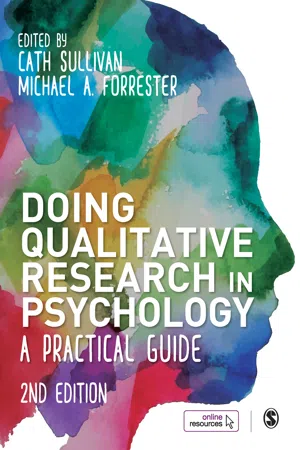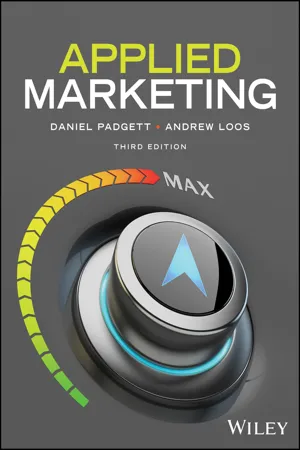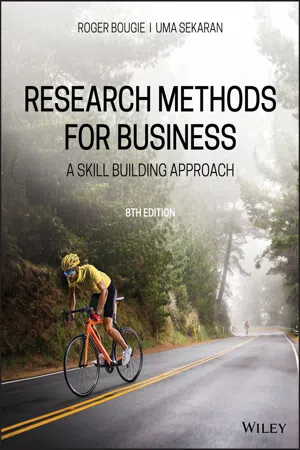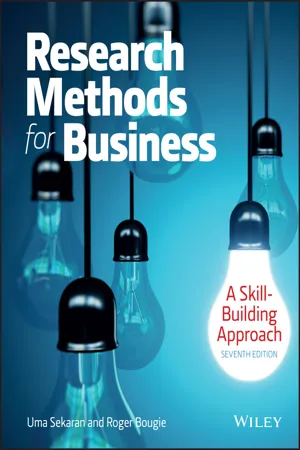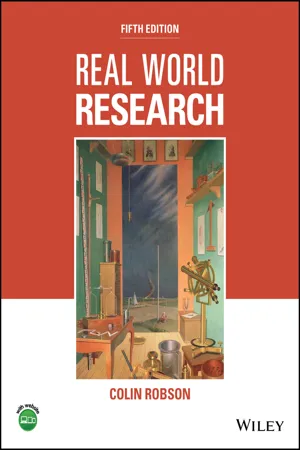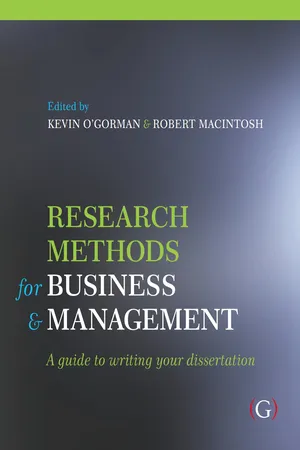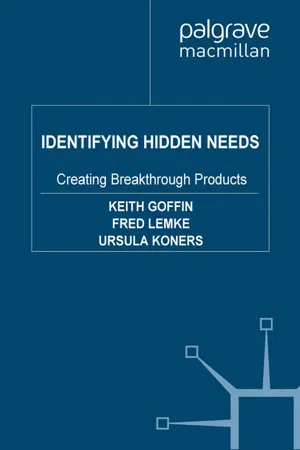Marketing
Interview in Research
An interview in research involves a structured conversation between a researcher and a participant to gather information and insights. It is a qualitative data collection method that allows researchers to delve deeper into the thoughts, opinions, and experiences of individuals. Interviews in marketing research are often used to understand consumer behavior, preferences, and attitudes towards products or services.
Written by Perlego with AI-assistance
Related key terms
1 of 5
9 Key excerpts on "Interview in Research"
- eBook - PDF
- Aparna Raghvan(Author)
- 2023(Publication Date)
- Society Publishing(Publisher)
In terms of data, qualitative research is quite adaptable. Structured and unstructured interviews are frequently used to characterize interviews. Most of us have participated in a market research interview on the street or over the phone at some point. Structured interviews are typified by such encounters. The interview questions are frequently read from a list, and the interviewee selects from a second list of possible responses for each question. The interviewer has very limited leeway to deviate from the prepared ‘script.’ To put it another way, everything is planned and predetermined to the greatest extent feasible. Almost always, rather than the researcher, the market research interviewer is a casual ‘employee’—that is, the real Qualitative Research Methods in Psychology 34 interviewer is a hired-hand. Structured interviewing accomplishes the following in general: • The interviewer makes certain that participants for the study have the necessary qualities to meet the sample requirements (this sort of sampling, known as quota sampling, is almost universal in this context). Furthermore, because the interviewer actively recruits study participants during the interview, reasonably large samples can be gathered quickly, as the interviewer usually stands on a busy street with many possible recruits passing by. For the participants, such interviews can be somewhat alienating. Because the interviewer usually only provides a limited number of options, the participant may feel unable to fully explain their true feelings. The data may be readily uploaded to a computer for analysis because of the multiple-choice pre-coded answer format. Qualitative researchers regard such procedures as alienating to the researcher as well, because the researcher is effectively separated from the research participants. - eBook - ePub
Doing Qualitative Research in Psychology
A Practical Guide
- Cath Sullivan, Michael A Forrester, Cath Sullivan, Michael A Forrester(Authors)
- 2018(Publication Date)
- SAGE Publications Ltd(Publisher)
7 The Interview in Qualitative Research Nigel King Siobhan Hugh-JonesIntroduction
Interviews remain the most pervasive form of data collection in qualitative psychology – and qualitative research more broadly. To some degree this may be a matter of habit; qualitative researchers have always used interviews, and so tend to teach their students (and future researchers) about the method. Writers such as Chamberlain (2012) have criticised the status of the interview as the default form of data collection that is often chosen without much consideration of alternatives, and we have some sympathy with that view. Nevertheless, we think there are positive reasons why the interview has endured so long and successfully. It is essentially about engaging with someone else’s experience and world view, which (in varying ways) is central to the mission of qualitative research. It puts the researcher’s own role in the production of knowledge centre stage, because of their direct engagement with the participant. At the same time, the interview is an established feature of everyday society, so much so that Atkinson and Silverman (1997) claimed that ours is an ‘interview society’. Consequently, participants are generally comfortable with their understanding of what will happen to them when they agree to be interviewed, which may not be the case with more unfamiliar methods.Figure 7.1 The ‘interview society’This chapter will help you to understand the different ways we can think about interviews, ways of conducting them and characteristics of a good interview. It will identify important considerations in recruiting participants and in preparing interview questions and guide you through the tricky aspects of actually doing the interview. Remember though that interviewing is a craft and the best way to become a good interviewer is through lots of practice; your first interview is unlikely to be your best! Finally, the chapter will consider some of the criticisms of interviews and potential limitations of interview data. - eBook - PDF
- Daniel Padgett, Andrew Loos(Authors)
- 2023(Publication Date)
- Wiley(Publisher)
Qualitative researchers also use focus groups to collect data. A focus group is a small group of 3–12 people, typically customers, assembled to provide feedback about a specific topic (see Figure 5.7). The group is led by a moderator, who guides the discussion to the topics the researcher wants to cover. A focus group can consist of a company’s customers, customers of another brand, or other combinations of informants from whom the company wants to get feedback about a topic. Focus groups provide quick information from a specific group, which is quite valuable. They are also typically less expensive than many other qualitative data- collection methods and thus can be a good value. A potential drawback of using focus groups is the possibility that the discussion will be biased if it is dominated by one or two individuals. Because the quality of the feedback is also directly related to the selection of the group and the skill of the moderator, careful attention must be paid to how the group is selected, and having a skilled moderator is essential. Perhaps the most commonly used qualitative data-collection method is personal inter- views. Personal interviews are exactly what the name implies—guided interactions with individuals. In marketing, personal interviews are mostly conducted with individual consum- ers on the consumer market side and with purchasing agents on the business market side. The major advantage of personal interviews is the ability of the interviewer to modify the questions as the interview unfolds, which can provide more detailed and valuable feedback for the company. Personal interviews are also flexible: The topic can be tailored to the individual being interviewed, or a general interview can ask the same questions of many customers. Interviewers can show customers ads, have interviewees listen to music, handle products—just about anything, which makes personal interviews one of the most flexible data-collection formats available to researchers. - eBook - PDF
Research Methods For Business
A Skill Building Approach
- Uma Sekaran, Roger Bougie(Authors)
- 2020(Publication Date)
- Wiley(Publisher)
These unobtru-sive sources of data and their use are important in research aimed at understanding behavioural. BOX 8.1 UNOBTRUSIVE METHODS Visit the companion website at www.wiley.com/go/bougie/researchmethodsforbusiness8e for Author Video: Interviewing . Interviews 119 A widely used method of collecting data in business research is to interview respondents to obtain information on an issue of interest. An interview is a guided, purposeful conversation between two or more people. There are many different types of interviews. Individual or group interviews may be unstructured or semi-structured, and conducted face to face, by telephone or online. Unstructured and semi-structured interviews will be discussed first. Some important factors to be borne in mind while interviewing will then be detailed. Next, the advantages and disad-vantages of face-to-face interviewing and telephone interviews are considered and then, com-puter-assisted interviews are described. A discussion on group interviews concludes this chapter. Managerial implications and ethics in interviews and other types of survey research are discussed in Chapter 10 after we have discussed interviews, observation and administering questionnaires in greater detail. UNSTRUCTURED AND STRUCTURED INTERVIEWS Unstructured Interviews Unstructured interviews are so labelled because the interviewer does not enter the interview setting with a planned sequence of questions to be asked of the respondent. At most, the researcher uses a topic list or an interview guide containing a list of things to be sure to ask when talking to the person being interviewed. Interviewees are allowed to respond freely in their own words about the topics the researcher brings to the conversation as well as on topics that they want to bring to the conversation. - eBook - PDF
Research Methods For Business
A Skill Building Approach
- Uma Sekaran, Roger Bougie(Authors)
- 2016(Publication Date)
- Wiley(Publisher)
Through this process, new factors might be identified, resulting in a deeper understanding. However, to be able to recognize a probable response, the interviewer must comprehend the purpose and goal of each question. This is particularly important when a team of trained interviewers conducts the survey. Visual aids such as pictures, line drawings, cards, and other materials are also sometimes used in conducting interviews. The appropriate visuals are shown to the interviewees, who then indicate their responses to the questions posed. Marketing research, for example, benefits from such techniques in order to capture the likes and dislikes of customers with regard to different types of packaging, forms of advertising, and so on. Visual aids, including painting and drawing, are particularly useful when children are the focus of marketing research. Visual aids also come in handy while endeavoring to elicit certain thoughts and ideas that are difficult to express or awkward to articulate. When a sufficient number of structured interviews has been conducted and adequate information obtained to understand and describe the important factors operating in the situation, the researcher stops the interviews. The information is then tabulated and the data analyzed. This helps the researcher to accomplish the task he set out to achieve, such as describing the phenomena, or quantifying them, or identifying the specific problem and evolving a theory of the factors that influence the problem, or finding answers to the research question. Much qualitative research is done in this manner. Review of unstructured and structured interviews The main purpose of the unstructured interview is to explore and probe into the several factors in the situation that might be central to the broad problem area. During this process it might become evident that the problem, as identified by the client, is but a symptom of a more serious and deep‐rooted problem. - eBook - PDF
- Colin Robson(Author)
- 2024(Publication Date)
- Wiley(Publisher)
Types and styles of interviews A distinction commonly made is based on the degree of structure or standardization of the interview: • Fully structured interview. This type of interview has pre-determined questions with fixed wording, usually in a pre-set order. The use of a greater number of open-response questions is the only essential feature that differentiates it from an interview-based survey questionnaire. • Semi-structured interview. Here the interviewer uses an interview guide, which serves as a checklist of topics to be covered. There is a default wording and order of the questions, but often both these features are substantially modified according to the flow of the interview, I N T E R V I E W S A N D F O C U S G R O U P S 3 7 3 and additional, unplanned questions are asked so that the interviewer may follow up on what the interviewee says. • Unstructured interview. The interviewer has a general area of interest and concern but allows the conversation to develop freely within this area. The interview can be completely informal. Semi-structured and unstructured interviews are widely used in flexible designs. A variety of terms are used to describe the kinds of interview used in such designs, for example ‘qualita- tive interview’, ‘depth interview’ (or sometimes ‘in-depth interview’), and ‘focused interview’ (where open-ended questions are asked about a specific topic or issue). When carried out in a group setting, such interviews are known as ‘focus groups’. Semi-structured and unstructured interviews are also used in life history and oral history research (see Chapter 15). Question focus A distinction is commonly made between seeking to find out what people know, seeking to find out what they do, and seeking to find out what they think or feel. This prompts questions con- cerned respectively with facts, with behaviour, and with beliefs or attitudes. - eBook - PDF
Research Methods for Business and Management
a guide to writing your dissertation
- Kevin D O'Gorman, Robert MacIntosh(Authors)
- 2014(Publication Date)
- Goodfellow Publishers(Publisher)
Unstructured inter -views elicit more information in a face to face format, whereas telephone-based formats may prove more suitable for structured interviews when a larger sample is required to strengthen validity, and the practicalities of meeting each respondent face to face are diminished. Ultimately, the most efficient way should be selected considering the resources available, appro -priateness to the context, and the added value of two-way interaction to the research. Access to appropriate participants is vital and must be realistic and achievable within any project timeframe. Interviewers must be able to brief gatekeepers and participants on the purpose of the project, as the initial exchanges can affect the rest of the interview. The briefing should include the following elements: What the data generated from the study will be used for Reassurances of confidentiality (see Chapter 11) How data will be recorded Length of the proposed interviews How many interviews the participant is committing to undertake Reassurance that the researcher’s role is non-judgemental but evaluative. Research Methods for Business and Management 116 Interview The interviewer has to be able to listen, prompt appropriately, and interact with the interviewee effectively. Good interviewers are personable, foster -ing trust and rapport with the interviewee. Gaining valuable data from an interviewee who is relaxed and enjoying the process is far easier than one who is on edge and suspicious. Table 7.2 illustrates interview stage tech -niques that can enhance interview quality Table 7.2: Interview techniques Activity Description Benefits Pilot study Ensures the study is designed correctly, but does not contribute towards data. Should resemble the actual study closely. Improves the robustness of the study. Allows early remediation of project design flaws. Settles the researcher into a routine and process they can execute confidently. - eBook - PDF
Identifying Hidden Needs
Creating Breakthrough Products
- K. Goffin, F. Lemke, U. Koners(Authors)
- 2010(Publication Date)
- Palgrave Macmillan(Publisher)
Selecting the Data Collection Method In designing the survey, the researcher has to decide on how to collect the data. Interviews and questionnaires are the two methods and both can be adminis- tered in several ways. Interviews can be conducted face-to-face, via video (such as Skype), or by telephone. Experienced interviewers are able to pick up a great number of cues in face-to-face interviews including extralinguistic signals (the tone of the voice) and body language (nonverbal communication, which is often culture specific). If the interview is conducted in the customer’s (or user’s) own environment— contextual interviews (see Chapter 4)—the researcher can ask questions based on the physical environment. Conducting interviews per video is a fast, cost effec- tive way to reach geographically dispersed respondents and body language may also be (partly) observed. In face-to-face, video, and telephone interviews, the rhetorical funnel guides the questioning. This “starts with a broad question and progressively narrows down to the important specific point or points.” 19 This approach allows the interviewer to react ad hoc to responses and ask respondents to expand on their answers. Such probing questions should be prepared in advance as semi- structured questions. Respondents are typically prepared to spend more time in SURVEYS AND INTERVIEWS 31 direct interviews—up to 60 minutes maximum (compared with completing a questionnaire, which should not take longer than 15–30 minutes). It can be valuable to interview managers who process expert knowledge of the topic being investigated. 20 Managers may ask whether, instead of several individual interviews, a group of managers can be interviewed together to save time. However, the respondents do not save time, as the interview is still 60 minutes per interviewee. As long as the goal of the study is not to explore team dynam- ics, we recommend individual interviews because peer pressure and group- think are eliminated. - eBook - ePub
- Chris Rice(Author)
- 2010(Publication Date)
- Routledge(Publisher)
Qualitative research is about understanding consumer behaviour. It is concerned with perceptions, feelings, attitudes, opinions, etc. In other words, it focuses on the emotional aspects of products, services and the decision-making process. Because of this emphasis, the majority of qualitative research tends to be carried out by talking to people, asking the open-ended ‘why’ questions to try to get to the real values underlying what may be a relatively superficial ‘I do not like that!’ reaction. Thus the form is primarily narrative and descriptive, and the main methods are depth interview and group discussion.Sampling
In many situations in which we find ourselves we will need information, and the population that we need to get the information from will be too large for us to ask everybody. An example with which we are all familiar is the opinion poll. Newspapers and television companies regularly want to produce pieces which will tell us how we will vote in an election (either real or imaginary). This is a typical situation when the population is too large to carry out a complete survey and only a sample will be examined. It is not possible to ask everyone of voting age how they are going to vote: it would take too long and cost too much (the same as the General Election we are investigating!). So a sample of voters is taken, and the results from the sample are used to estimate the voting intentions of the whole population. Similarly, we will come across research which purports to tell us what the nation thinks of the Royal Family at a given point in time – but I have never met anybody who has been asked!Some definitions
Census – Occasionally a population is small enough for all of it to be examined – for example, the attitudes of the class of students who are taking the ‘Understanding Customers’ course. When all of the population is examined, the survey is called a census.Sampling
Index pages curate the most relevant extracts from our library of academic textbooks. They’ve been created using an in-house natural language model (NLM), each adding context and meaning to key research topics.

